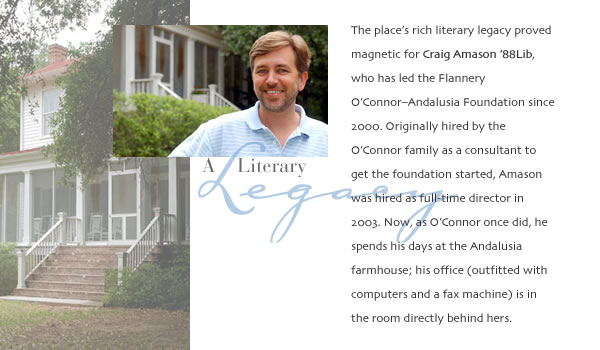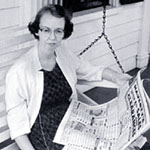
The farm, the core of a 1,700-acre antebellum plantation, was first purchased by Dr. Bernard Cline of Atlanta, Regina Cline O’Connor’s half-brother, in the early 1930s. Cline named it Sorrel Farm because of the sorrel-colored horses he kept there. But shortly after Regina, O’Connor’s mother, inherited the property in 1947, O’Connor met a descendant of one of the previous owners who told her it was once called Andalusia after the historic province of southern Spain. Perhaps this name better appealed to her artistic sensibilities; she reclaimed it for the farm.
 Born
in Savannah in 1925 to Regina and Edward F. O’Connor Jr., O’Connor
grew up and attended Catholic schools in Savannah and Atlanta. In 1940,
the family moved to Milledgeville, where she went to Peabody High School
and Georgia State College for Women. An only child, she often visited
Andalusia as a teenager with her cousins. In 1941, her father died of
lupus, the same disease that would eventually take O’Connor’s
life at thirty-nine.
Born
in Savannah in 1925 to Regina and Edward F. O’Connor Jr., O’Connor
grew up and attended Catholic schools in Savannah and Atlanta. In 1940,
the family moved to Milledgeville, where she went to Peabody High School
and Georgia State College for Women. An only child, she often visited
Andalusia as a teenager with her cousins. In 1941, her father died of
lupus, the same disease that would eventually take O’Connor’s
life at thirty-nine.
In 1945, O’Connor left Georgia to attend a writer’s workshop at the University of Iowa in Iowa City, where she wrote her first collection of short stories, The Geranium, as her master’s thesis. Now firmly set on making a life of writing, she went to New York and began to find her way among other authors and artists, including poet-translator Robert Fitzgerald and his wife, Sally. Theirs would prove an essential friendship for O’Connor. When the Fitzgeralds moved to the country in Connecticut in 1949, they invited her to come and live with them as a boarder and babysitter. It was there that O’Connor made considerable early progress on her first novel, Wise Blood.
But when lupus began to sap her strength, she came home to Georgia and her mother. The life the two women created for themselves at Andalusia was far from an isolated, lonely existence, however. By all accounts, O’Connor lived full years at Andalusia, entertaining visitors both literary and purely social. She also spoke about writing for various groups.
“People were out here all the time—locals, famous writers, school groups,” Amason says. “They would come to see Flannery, or Regina would have them out to see the dairy. Plenty of people remember visiting out here as a child.”
|
“The
place was very important to Flannery’s art,” Amason says.
“Many of her stories take place on a farm.”
|
Regina proved herself an adept dairy farmer, providing a steady income for the farm while Flannery enjoyed her most productive years as a writer. Her habit, according to Amason, was to write every morning until noon, then spend the afternoons tending to her peafowl and other birds or entertaining guests. The running of the farm itself, and the hired hands who helped Regina work it, supplied
O’Connor with no end of colorful material for her fiction; she often wrote to her friends about the goings-on at Andalusia. “The place was very important to Flannery’s art,” Amason says. “Many of her stories take place on a farm.”
Mary Barbara Tate, a member of the Flannery O’Connor–Andalusia Foundation board of directors, fondly remembers her visits to Andalusia during O’Connor’s time there. A professor of English at Georgia College and State University for twenty-three years, Tate belonged to a reading group that met every week at the farmhouse to discuss Southern literature chosen by O’Connor. Once, O’Connor read aloud her short story The Enduring Chill before she sent it off for publication.
“We enjoyed that very much,” Tate says. “She laughed and laughed as she read it. It was wonderful for us.”
O’Connor’s room, which served as both bedroom and study because her health would not allow her to climb the stairs, remains today much the way she left it: a narrow bed, 1950s floral curtains, a wooden desk and chair, and shelves filled with books. The crutches she used when she became disabled lean against a shelf. Although the desk and chair were not actually O’Connor’s, much of the furniture in the house is original or from the same era—particularly the kitchen, which is, as Amason says, “Absolutely vintage.”
The rooms arranged for public viewing include O’Connor’s room, the parlor, kitchen, and another sitting room at the rear of the house, as well as a small gift shop and business office. The second floor is not currently open to the public but instead serves as a storage area for much of the home’s contents, including box after dusty box of Regina’s meticulous farm records (she was famous for following the guidelines of the Georgia Agricultural Board to the letter). A dozen rocking chairs on the wide, screened-in front porch beckon visitors to sit awhile. The 544-acre estate also includes the Hill House where farm workers once stayed, the cow barn, the milk processing shed, and some smaller buildings, as well as a a great blue heron rookery, a livestock pond, and a mule.
|
“There
are people who are kooky about Flannery,” Amason says. “They
have left things on her grave—pennies, |
Since the house was opened to the public last spring, Amason says, some eighteen hundred visitors have walked through, seeing the O’Connors’ home much as it must have been nearly a half-century ago. They range from school groups to tourists “just passing through on their way to Disney World” to devoted O’Connor scholars, Amason says.
“There are people who are kooky about Flannery,” he says. “They have left things on her grave—pennies, a glass rose, a paperback book. People have actually made a pilgrimage to come here. They stand in the doorway of her bedroom with tears in their eyes. It’s very touching.”
Amason understands. As a college student at the Georgia College and State University, he fell in love with O’Connor’s fiction and was “smitten” from then on. “I think it’s because I know these people—I am these people,” says Amason, a Macon native. “I’m in these stories. It’s the humor that drew me in. I do understand the larger themes of grace and salvation, but what really caught my attention was the way she described these people just right. They are people who can laugh at themselves.”
Georgia College and State University, where most of O’Connor’s manuscripts and correspondence reside, has been a center of O’Connor scholarship since the 1970s. Amason earned a master’s degree in history there in 1985, focusing on desegregation in Georgia’s Baldwin County. He then went on to receive a master’s of librarianship from Emory in 1988, commuting the two hours from Milledgeville to his Emory classes while also working at the town’s public library. Later, in 1997, he became director of the Milledgeville Public Library.
Regina O’Connor moved from Andalusia to another family house in Milledgeville after O’Connor died, where she stayed until her own death in 1995. Regina’s will established an organization to care for Andalusia and to honor her daughter’s work. “I think her mother was a little amazed at the reputation Flannery achieved during her life and, after her death, even more so,” Tate says. “She truly cherished the idea that Flannery had this worldwide appreciation.”
The attorney for O’Connor’s estate, knowing of Amason’s fondness for Flannery’s fiction and his deep roots in the culture of the area (“This is a small town,” Amason says), contacted Amason about helping to get the Flannery O’Connor–Andalusia Foundation up and running.
Amason works closely with the foundation’s board of directors, about a third of whom are members of the O’Connor family. While the foundation paid for the major aspects of Andalusia’s restoration, many of the board members pitched in personally to help with cleaning and beautifying the place. “We had ladies in their late seventies scrubbing baseboards,” Amason says. “They knew Flannery.”
In the year since Andalusia opened, the number of hits on its web site and the number of feet through its front door has grown from a trickle to a steady stream. More than two hundred visitors came August 3 for the celebration and twenty-four-hour reading vigil honoring the fortieth anniversary of O’Connor’s death.
“I believe this is one of the most important literary landmarks in the country,” says Amason, who envisions Andalusia becoming something like the Carl Sandburg house in North Carolina.
“I just get a very wonderful feeling when I go there,” Tate says. “The O’Connors did so much of their entertaining on that porch. It was screened then, as it is now; there were rocking chairs then too. I’m very happy to go there and sit and look at that wonderful view again, just to be there.”